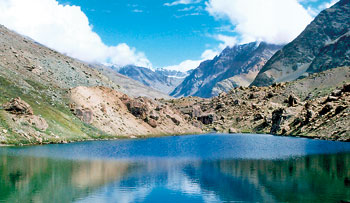The drive to Leh was breath taking - stark, towering, stalagmite formations, small glacial lakes, craggy mountains of various hues (purples, rust, chocolate brown with a smattering of icing sugar, sandstone, a painter's palette of various hues, blue skies, cloud formations over the snowy tips) yaks at high pastures. The Guide Book had classified it as one of the most breath-taking drives and I had to agree. In the absence of traffic lights, we paused at regular intervals for the passage of shepherds with their goats and sheep.
Wayside stops for cooked lunches of our choice and tea; drives up to 9,000 ft then down to 6,000 ft, then again up to 15,700 ft, down again and then the highest point 17,500 ft the second highest road in the world and finally Leh with an altitude of 11,000 ft.
 |
| A glaciel lake on the drive to Leh |
Altitude sickness is one discomfort the traveller faces and we dosed ourselves with Diamoxcin daily. I drank coca tea given by a friend, which is suitable for high altitude travellers. Despite loss of appetite and fatigue on the first day, gradually as I got acclimatised I got used to the thin air. A lady whom I met in the hotel told me that her husband was pretty bad and had to be given oxygen.
Ladakh in the State of Jammu and Kashmir is one of the remotest regions in India and marks the boundaries between the peaks of the Western Himalayas and the vast Tibetan plateau. It is also described as moon land. With a predominantly 70 percent Buddhist population and 30 percent Muslim population, there was some friction in the past, but the issues have now been addressed. Kargil where the famous war in 1999 with Pakistan was fought is predominantly Muslim.
The main sources of income are tourism in the summer months and the large military presence, it being near the border with both China and Pakistan. After the success of the Kargil war where many Ladakhis assisted the Indian army in the war, a unit called the Ladakhi Scouts has been formed, as they are adept at fighting in high altitude conditions.
Electricity is a problem and the residents are subject to many power cuts during the day but a new hydro power plant will be complete by 2012. A number of concessions have been made to the Border States such as educational opportunities in the form of scholarships, and commodity prices remain the same as in Delhi.
We visited four of the main monasteries and climbing the steep steps, one had to pause to catch one's breath in high altitude conditions.
The 17th century Hemis Gompa monastery with 250 monks belongs to the Drupka order. It is of great importance to the people of Ladakh, who have to visit this gompa at least once in a life-time. The largest thangka studded with pearls and precious stones is here and is unfurled every twelve years to commemorate the Indian sage, Padmasambhava. The museum is of great interest with items depicting the practices and Tibetan way of life.
Tiksey Gompa belongs to the Dalai Lama's order and is situated imposingly on a hill overlooking the valley. It has a huge imposing statue of the Buddha and beautiful paintings depicting the Gods of the Tibetan School of Buddhism.
The gompa that appealed to me greatly was Alchi on the banks of the Indus River with the magnificent 11th century figures of the Bodhisattva, Avalokiteshvara and Manjushri (God of Wisdom) housed in a three storey temple with traces of the Hindu school of influence. The intricate miniature paintings on the dhotis trace the history of their reincarnations, and historic significance. No photos were allowed but the splendour of those beautifully large crafted figures and colours used are etched in my memory. The religious enclave is considered one of the greatest art treasures of the Buddhist world.
The Likir gompa was one of the first built in Ladakh. Rebuilt in the 18th century it belongs to the Gelupa Sect. A huge Buddha figure 25 feet tall outside overlooking the valley and some old paintings are the features of this monastery. The gompa is managed by the Dalai Lama's brother and holds its festival in winter when sacred dances are performed by the monks.
Stok Palace, the residence of the Royal family, who now have no powers, has beautiful views of the valley. The museum has artefacts, old thangkas, traditional Royal jewellery (made from turquoise, pearl, coral and silver), clothing and photographs. The Queen Mother was a member of the Indian Parliament for five years and was instrumental in developing the region.
Since I carried a Sri Lankan passport, I was not allowed to visit Pangong, the highest glacial lake near the Tibetan border at an altitude of over 15,000 ft. 150 km long and 4 km wide, a quarter of the lake is in India and the rest in Tibet.
Hot and dusty, Leh gets cold at night. It has shops selling Kashmiri items, Tibetan jewellery and other trinkets. The older generation favour traditional clothing and carry Buddhist rosaries with them, chanting while walking.
The Himalayan range is certainly the Abode of the Gods and a place where the Mahayana practices are carried out with dedication and devotion. Ladakh is not for the faint-hearted, but for those with a sense of adventure, a thirst for new experiences and a spiritual outlook.
Flying back through Delhi, I went to see the church where my parents were married - St. James, in Old Delhi. What a discovery - the church was the church of the Viceroys of India, built by Col. James Skinner and the stained glass windows and structure are magnificent. |


